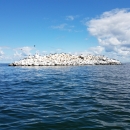About Us
Crane Meadows National Wildlife Refuge was established in 1992 to protect one of the largest, most intact wetland complexes remaining in central Minnesota. Currently composed of 14 parcels of land, the refuge encompasses approximately 2,150 acres. It features a unique sand plain wetland/upland complex with a rich mosaic of healthy sedge meadow, shallow lake, oak savanna, prairie, shrubland and forest habitats. It encompasses a large wetland system at the confluence of four tributaries that feed high quality water to Rice and Skunk Lakes and the Platte River. The Rice-Skunk Lakes complex features one of the largest unaltered sedge meadow wetlands in Minnesota. This complex provides critical habitat for waterfowl, shorebirds, sandhill cranes and many other species of birds. With the areas importance to breeding and migrating birds, the refuge is included in the Crane Meadows National Wildlife Refuge - Rice Skunk Wetland Complex, State Important Bird Area.
Our Mission
The mission of the National Wildlife Refuge System is to administer a national network of lands and waters for the conservation, management and, where appropriate, restoration of the fish, wildlife and plant resources and their habitats within the United States for the benefit of present and future generations of Americans.
Every national wildlife refuge national wildlife refuge
A national wildlife refuge is typically a contiguous area of land and water managed by the U.S. Fish and Wildlife Service for the conservation and, where appropriate, restoration of fish, wildlife and plant resources and their habitats for the benefit of present and future generations of Americans.
Learn more about national wildlife refuge was created for a special purpose. Some were created to protect migratory birds, others to protect threatened or endangered species or unique habitats, while others fulfill another special purpose. All activities allowed on refuges must be evaluated to make sure each activity will not conflict with the reason the refuge was founded.
The first purpose of the refuge is for the conservation, management and restoration of fish, wildlife, plants and their habitats for the benefit of present and future generations of Americans.
The second purpose of the refuge is for the conservation of wetlands, which provide benefits to wildlife, migratory birds and the American public.
Our History
1990 -A formal study and assessment of 35,000 acres in the Rice-Skunk Lake area began to assess the area’s potential as a nationally significant wetland complex to be designated as a national wildlife refuge national wildlife refuge
A national wildlife refuge is typically a contiguous area of land and water managed by the U.S. Fish and Wildlife Service for the conservation and, where appropriate, restoration of fish, wildlife and plant resources and their habitats for the benefit of present and future generations of Americans.
Learn more about national wildlife refuge .
1990 -The Nature Conservancy purchased five properties, which would become the first refuge lands after refuge establishment.
July 1992 -A final environmental assessment was completed and officially authorized a 13,540 acre refuge.
1995 -The first and only congressional appropriations for land acquisition allowed the U.S. Fish and Wildlife Service to purchase the properties held by The Nature Conservancy and add others that were available from willing sellers.
1997 -The Platte River Trail, the focal point for many visitors, was constructed and opened to the public.
2008 - The Platte River Trail was upgraded from a grass trail to one with a crushed granite base.
September 1, 2019 -The refuge opened to public hunting for big game, small game, furbearers and migratory birds.
Other Facilities in this Complex
Crane Meadows National Wildlife Refuge is part of a complex that includes four national wildlife refuges located throughout east central Minnesota, including Sherburne, Crane Meadows, Rice Lake and Mille Lacs national wildlife refuges. These refuges are under shared management, with complex headquarters located in Zimmerman, Minnesota.


